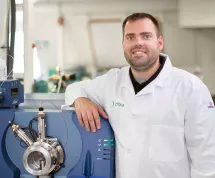Search
Explore content from JFS, ASB, the AAFS Newsfeed, and other content using the search bar or filters.
Epic Deals for Members—October 25
Thank You for Completing the Membership Survey
AAFS Jurisprudence Section Leadership/Committee Positions
The effect of handedness and biological sex on fingermark ridge height and volume as...
For decades, detectives and forensic scientists have relied on friction ridge skin comparisons to identify individuals in criminal investigations. This method involves examining (latent) fingermarks, typically captured as two‐dimensional (2D) images, and comparing them with known...
Alex Krotulski to Receive the 2025 Outstanding Early Career Achievement in Forensic...

Annual Dues September Drawing Winner
Don’t Miss Your Chance to Save—AAFS 2025 Early Bird Rate Ends October 31!
Remembering Richard Gerald (Jerry) Snyder, PhD
The relationship between four indicators of future time orientation, criminal thinking...
Individuals who commit criminal behaviors are often thought to prioritize short‐term goals rather than long‐term goals (i.e., a present vs. a future time orientation). Though previous theories of crime and empirical research support a relationship among future time orientation, c...
Development of a forensic DNA research grade test material
Advancements in forensic DNA typing technology and methods have increased sensitivity and, while beneficial, carry the weight of more challenging profile interpretation. In response, the forensic DNA community has often requested more complex reference materials to address common...
Results of a large‐scale humeri pair matching study
During the analysis of a commingled human remains assemblage, pair‐matching is often conducted as part of the inventory to inform the DNA sampling strategy and to calculate the minimum or most likely number of individuals. As commingled assemblages become larger, pair‐matching be...
A preliminary study of the manufacturing of breech faces
Firearm examiners may face challenges with subclass characteristics. Subclass characteristics have the potential to be confused with individual characteristics if a careful analysis for the presence of subclass characteristics is not performed. Several case studies are reported i...
Attenuated total reflection Fourier transform infrared spectroscopy (ATR‐FTIR) analysis of...
A person's age estimation from biological evidence is a crucial aspect of forensic investigations, aiding in victim identification and criminal profiling. In this study, we present a novel approach of utilizing Attenuated Total Reflection Fourier Transform Infrared (ATR FT‐I...
Bed bugs, Cimex lectularius: Undercover agents in forensic investigations
Insects have long played a role in forensic investigations and can be used to estimate minimum time since death, corpse translocation, and link an individual to a crime scene. Bed bugs (Cimex lectularius) are wingless ectoparasitic insects of potential forensic utility, given tha...
The application of GIS technology in building a multivariate taphonomic profile for...
Environmental conditions highly affect decomposition rates and therefore a forensic practitioner should consider context‐specific information when estimating the post mortem interval (PMI). Traditional methods of collecting environmental data, however, are time‐consuming and ofte...
Advances in Ambient Ionization Mass Spectrometry for Synthetic Opioid Analysis
Ambient ionization mass spectrometry (AI-MS) is an increasingly adopted tool for seized drug analysis in both traditional laboratory and forward operating laboratory settings that has shown to be useful for the detection and identification of fentanyl and other synthetic opioids. Recent advances in the field of AI-MS have been demonstrated from sample collection to analysis to data interpretation. This 1 hour webinar will discuss some of these recent advances and highlight their applicability for forensic applications.
